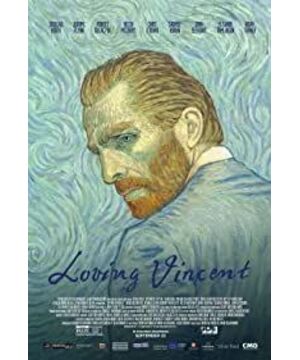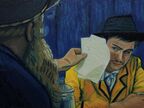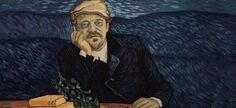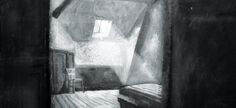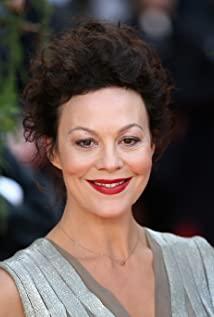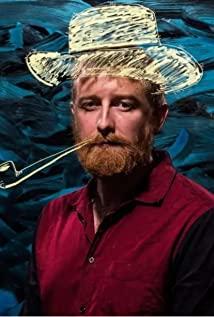"15 countries, 125 painters, 3 weeks of training, more than 4 years of production, 65,000 oil paintings". Suffering is now the main tone of animation film promotion, and it does sound like a legend. In fact, these figures are nothing more than restoring an animation technology more than 80 years ago - Rotoscope.
Rotoscope is an animation technique in which an animator traces the real movement of the painting frame by frame based on the real shooting material. The earliest dynamic rotoscoping technique was to drop pre-filmed footage onto frosted glass, which animators then painted frame by frame. This projector is called a Rotoscope. The principle is somewhat similar to the film enlarger + copy table.
For "Love Van Gogh", simply put, it is to shoot a live-action film of "Love Van Gogh", actors, photography, lighting, costumes and props, everything is based on film standards until the editing is completed. Then start animation production, invite global painters to do a Van Gogh imitation show, and turn photos into paintings. I don’t know if there are any Chinese Dafen Village painters to join. . .
Regarding dynamic rotoscoping, it can be traced back to the Disney era when animated films were just invented. The first attempt was in a movie, in 1937's Snow White and the Seven Dwarfs. In 1941, China's first feature-length animation "Princess Iron Fan", created by the three Wan brothers, also completely followed the dynamic rotoscoping technique.
Dynamic rotoscoping is not an advanced technique. Just appeared as a hand-drawn animated baby walker. At that time, hand-painted celluloid technology was just invented, and it was the only animation production technology at the time. This technique requires the artist to complete frame-by-frame animation drawing. But there were few painters of that era who could capture the movement with complete imaginative dexterity. Therefore, Rotoscope, like a child's walker, has become a technology that assists painters to capture the dynamics. Movies are 24 frames per second of photos, (full) animations are 24 frames of painting per second. The animator borrowed the film to assist in the production of animation, which must have been the most cutting-edge high-tech at that time.
Looking at it this way, the animation in the animation "Love Van Gogh" is, to put it bluntly, an animation of riding a walker. Animation is more of a craft on the assembly line in this film. Some even call it a "human filter". In this era of P-pictures with artificial intelligence and big data, a filter still needs 125 people? 4 years? 65,000 paintings? Are you kiding me? Never used Instagram? Going to the West Second Banner to draw two code farmers, wouldn't it be compiled in a week? For them, once the actors are involved in the animation, the mystery of the animation will be lost. The animation seems too crafty. This is a prejudice from insiders.
In fact, it is not uncommon to use dynamic rotoscoping to make animations in recent years. Another example, from Shunji Iwai's "The Murder Case of Flower and Alice", is also produced with dynamic rotoscoping. The production method is similar to "Beloved Van Gogh". Because of his popularity, he will even invite Aoi and other first-line stars to participate in the show. After the animator's dynamic rotoscoping, the actor didn't even know his mother except for his voice. Before "The Murder Case of Flower and Alice", I also tried another animation series "Town Youth" consisting of three short films, "First Smell of the Sea Tide", "For This Long Distance", "Read Your Dreams" ".
The dynamic rotoscoping is obviously helpless to Iwai Shunji, because I can't draw, let alone animation. However, Shunji Iwai, who was born as a real film director, has a different understanding of performance than an animator. The performance of animation comes from the drawing of the animator, and for animation, the animator is the actor. The performance of animation is actually too stylized, such as externalized performance, big movements, exaggeration, elasticity, etc. Animators with a professional background are generally trained in this way. They don't show delicate movements, like micro-expressions, let alone performative states. Shunji Iwai's dynamic rotoscoping comes from a real actor, giving the animated characters a human soul, rather than a hollow soul fabricated out of thin air. Human performance is direct, and it comes from the heart, while animation is indirect, and animators have a secondary creation for performance. After all, it can only be an expressionist performance. Those who reject dynamic rotoscoping are actually rejecting the actor's violation of the second dimension. But let go of an obsession with animation, there will be another feeling, dynamic transfer drawing gives animation a human taste.
Another significance of dynamic rotoscoping for "Love Van Gogh" is that he turned the oil painting into a dynamic texture. Starting with the starry sky in the first shot, a peculiar visual interest arises when Van Gogh's naive lines and strong colors come into play. Animation turned out to put aside the story, put aside the art design, just make the painting move, it is enough to become a spectacle. The power of animation ontology language emerges. The root word animation means to give something to the soul. There was a sense of creation in it.
Can the 125 painters in "Love Van Gogh" be replaced by two Xierqi code farmers? This seems to be asking, can machines replace people? Vincent van Gogh's paintings come from the heart, and it is through the clumsy work of the heart, eyes, and hands that painting can inject spiritual power into painting. Dynamic rotoscoping is a kind of collective work of people. Every frame of hand-painting is infused with a small amount of spiritual power, which can be gathered into powerful energy, making the time of the movie look warm. This is also the most simple ontology of animation. The dynamic redrawing in "Princess Iron Fan" is still a kind of helplessness that the child has not grown up yet. "Love Van Gogh" is an active choice, making Van Gogh's painting come alive, it seems that it has also brought Van Gogh to life again. This is not comparable to filters.
Technical Darwinism in Chinese animation. The Chinese animation industry's attitude towards technology is a set of laws of the jungle, the survival of the fittest. A new technology will inevitably replace the old technology. 3D animation instead of 2D animation, VR animation instead of 3D animation, I heard too much. We take technology too seriously. At the same time we do not value technology. We once invented ink animation technology, paper-cut animation technology, and with the advent of computer technology, all these microscopic technologies became garbage and were completely discarded. This kind of technical Darwinism is actually just a kind of imitative thinking. Art is created by detailed techniques, and techniques as art may not be ready to use.
View more about Loving Vincent reviews


